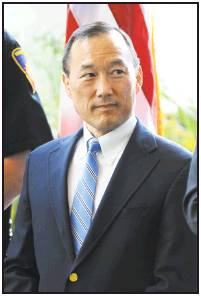EARL KIM
There is nothing average about Stamford students
Stamford Public Schools’ (SPS) graduates are everywhere. Just look around. They are teachers, tradesman, governors, actors, business owners, Emmy nominees, financial planners and university presidents, to name just a few. We are proud of them and value their contributions to our community. Their careers and their paths to success are as varied as they are. And I’d venture that their SAT scores and those of their classmates were just as varied. So does a one- or four- or even nine-point decline in average ELA or Math SAT scores from last year make those graduates any less likely to be successful?
Yet year after year reporters, and parents alike, choose to look at average SAT score as an indicator for the success of students in the city or as a reflection of the effectiveness of our district schools.
Consider this: There is nothing average about a Stamford student. SPS graduates represent a broad spectrum of experiences, including many students who are taking a standardized test for the first time, who are new to the country or for whom English is not their first language. Stamford also has many students whose parents spare no expense for SAT prep courses or private tutors, or who have taken many practice tests before sitting for the actual exam. And, in Stamford, we have a handful of students somewhere in the middle. This phenomenon is why our scores do not follow a regular bell curve — with many scores in the middle and a few on the high and low ends. Instead, our scores look more like a two-humped camel — with a majority of scores at either end of the spectrum and very few in the middle. Therefore looking at that average, or mean score, is meaningless. It is not a true representation of our students.
While state standardized test scores are important for SPS to track academic progress, we need to be reflective on their use. First, the SAT school day exams are administered once to 11th-graders. Comparing the results of one 11th-grade cohort to another does not provide a true measure of growth, which is the best way of monitoring academic progress. Next, while academic progress is essential it is not sufficient, since SPS’s vision is to educate the whole child —heart and body — in addition to mind. Finally, one shouldn’t make an inference between test scores and school effectiveness without controlling for multiple mitigating factors, such as language barriers, student transiency or attendance.
Since coming to Stamford I have made it my business to meet with neighborhood organizations, reporters and parent groups to share the success of our schools and our students. And many are pleasantly surprised by what they hear and excited to share the positive outcomes with others. I have also taken many opportunities to explain the anomaly of our student scores, whether it is SATs or any number of standardized tests, so parents can better understand why comparing average test scores here with other communities is not an apple-to-apple comparison. After all of that, it is disheartening that the narrative, whether published in the paper or spoken on the streets, is still focused on the numbers. And it is even more distressing when our own local paper, with whom we have met numerous times, still publishes that narrative with no context or explanation for why the numbers look the way they do and instead chooses inflammatory words such as “stumble” and “tumble.”
Looking forward to the coming school year, as a district we are executing on our strategic plan and finalizing our school-based initiatives to improve student learning. I remain hopeful that community members will embrace and support our mission of providing an education that cultivates productive habits of mind, body and heart in every student and participate in community conversations to promote our shared vision. After all, there is nothing average about Stamford students.
Earl Kim is superintendent of Stamford Public Schools.
SPS graduates represent a broad spectrum of experiences, including many students who are taking a standardized test for the first time, who are new to the country or for whom English is not their first language. Stamford also has many students whose parents spare no expense for SAT prep courses or private tutors, or who have taken many practice tests before sitting for the actual exam.
